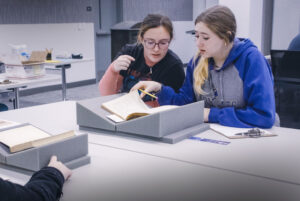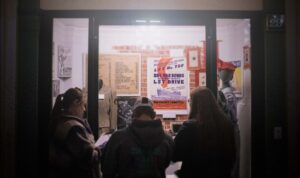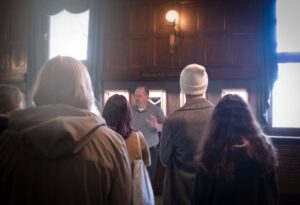By Kyle Warmack
 This fall, students at two high schools in West Virginia will embark on the third annual cycle of a unique and powerful journey: diving deep into the lives of ordinary Mountain State veterans interred at the national cemeteries in Grafton, WV. For many of the young participants, it will be their first real steps into the historian’s craft, wading through primary source documents such as census records and military reports to draw out the story of each veteran’s service.
This fall, students at two high schools in West Virginia will embark on the third annual cycle of a unique and powerful journey: diving deep into the lives of ordinary Mountain State veterans interred at the national cemeteries in Grafton, WV. For many of the young participants, it will be their first real steps into the historian’s craft, wading through primary source documents such as census records and military reports to draw out the story of each veteran’s service.
The program that makes it possible, the West Virginia National Cemeteries Project (WVNCP), is the brainchild of the West Virginia Humanities Council.
“We’ve been one of the state’s biggest cultural grant makers for 50 years,” says Program Officer Kyle Warmack. “We support libraries, historical societies, museums and many other cultural organizations through our programs and grants, but this one is really special. We don’t do anything else like it.”
Compared to the Council’s five-decade track record, the WVNCP is in its relative infancy. But it’s going strong thanks to funding from the U.S. Department of Veterans Affairs (VA) through the Veterans Legacy Grant Program (VLGP).
“The VLGP makes this all possible,” says Warmack. “There’s no way we could be this supportive of the students and their work without their helpful team and generous funding.”
 In the coming year, those 40-odd students will come from Grafton High School in Taylor County and University High School in Monongalia County. They work in pairs or small groups to research individual veterans, and are guided and assisted by a team of six West Virginia University (WVU) graduate history students. Warmack notes that the WVU students—a mix of Masters and Ph. Ds—serve as role models to the high-schoolers by showcasing an indomitable passion for American history and the craft of research.
In the coming year, those 40-odd students will come from Grafton High School in Taylor County and University High School in Monongalia County. They work in pairs or small groups to research individual veterans, and are guided and assisted by a team of six West Virginia University (WVU) graduate history students. Warmack notes that the WVU students—a mix of Masters and Ph. Ds—serve as role models to the high-schoolers by showcasing an indomitable passion for American history and the craft of research.
Eventually, all this research will coalesce into short, narrative biographies of the chosen veterans, complete with photographs and bibliographies.
“We encourage the students to look deep into the context surrounding their veterans’ lives—what was the town like where they grew up? What are the granular details of their service?” says Warmack. “We’ve had a Navy diver and an aerial reconnaissance photographer. There has been a Marine aviation mechanic who never saw action, but also a Marine lieutenant who won the Silver Star for his conduct at the Chosin Reservoir. The range is incredible, because the only qualification is that the national cemetery is their final resting place. The real point is, they were all willing to serve.”
 U.S. Senator Shelley Moore Capito’s office says of the WVNCP, “This program has the unique ability to unite generations of West Virginians. The funding announced today from the VA will cement the legacy of West Virginia service members through the diligence and study of students who are sharing their stories of service.”
U.S. Senator Shelley Moore Capito’s office says of the WVNCP, “This program has the unique ability to unite generations of West Virginians. The funding announced today from the VA will cement the legacy of West Virginia service members through the diligence and study of students who are sharing their stories of service.”
U.S. Senator Joe Manchin III called the students’ work “an incredible accomplishment,” and thanked the project “for memorializing these great Americans.”
Warmack says the Council is grateful that the Veterans Legacy Grant Program, which requires congressional approval, has received vigorous support from all of West Virginia’s representatives on Capitol Hill.
Read the veteran biographies and more about the project at wvhumanities.org.








